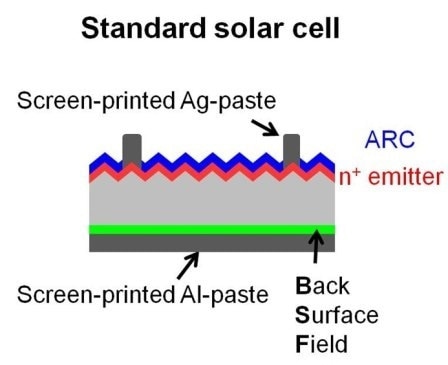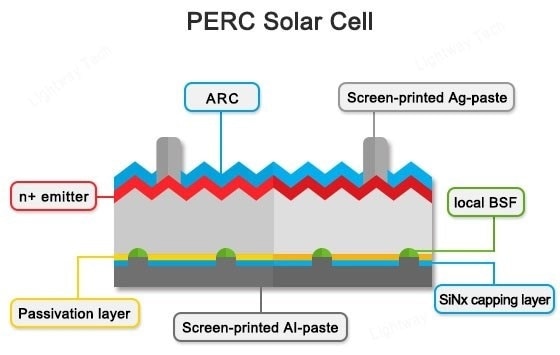Solar cells convert sunlight (photons) directly into electricity through the photovoltaic effect. The cells can be used to power consumer products, such as electronic toys and portable radios. However, they can also be used in larger systems in fields and on commercial roofs, contributing to renewable energy supply.
They can also be wired together to form panels to provide electric power to households, which is especially use for homes in remote areas where conventional electric power sources are unavailable. Solar cells also provide power for most space installations.
A group of solar panels can be arranged to form arrays which can generate electricity on a larger scale for distribution to industrial, commercial, and residential users.
At least three structure elements are needed for a solar cell to work:
- Absorber – typically a semi-conductor such as silicon which absorbs incoming photon and translates their energy to an excited state of a charge carrier;
- Membrane – usually a pn-junction which prevents the excited carrier to recombine to its ground state; and,
- Contacts – which allow for the carriers to be collected and for the cell to be interconnected to other solar cells or to an outer load.
Standard Solar Cells
The standard solar cell structure that has been in use for decades and makes up around 80% of the world market share is as follow:
From front to rear side of the cell:
- Screen-printed Silver paste front contact;
- Anti-Reflective Coating (ARC);
- Silicon wafers that form the P-N junction;
- Aluminum Back Surface Field (Al-BSF); and
- Screen-printed Aluminum paste layer

Image Credits: Institute for Solar Energy Research Hamelin (ISFH) as cited in https://www.powerfromsunlight.com
These cells are usually Crystalline Silicon cells with high energy conversion efficiency rate. This means that the cells, formed into panels, can generate more power even though the panels are just large enough to fit into limited spaces such as rooftops, making them space-efficient and in the long run, cost-efficient.
The success of this cell structure is attributed to the following:
- Simple production technology in comparison to the efficiency being obtained;
- Tolerant structure and process against variations of the wafer quality; and
- Readily available production technology, i.e. vital structure elements or process sequences are not severely protected by patents or other legal issues which allowed many manufacturers to compete.
Although solar technology has greatly improved in terms of efficiency and cost, it is still more expensive than traditional energy sources. Hence, continuous research is being done to further reduce production costs and increase efficiency to generate more power.
PERC Solar Cells
PERC, which stands for Passivated Emitter and Rear Cell or Passivated Emitter and Rear Contact, is a new technology aimed to achieve higher energy conversion efficiency by adding a dielectric passivation layer on the rear of the cell.
The structure of a PERC solar cell from front to rear:
- Screen-printed Silver paste front contact;
- Anti-Reflective Coating (ARC);
- Silicon wafers that form the P-N junction;
- Local Aluminum Back Surface Field (Al-BSF);
- Dielectric passivation layer;
- SiNx Capping Layer; and
- Screen-printed Aluminum paste layer

Image Credits: https://www.enfsolar.com as cited in https://www.powerfromsunlight.com)
The dielectric passivation layer contributes to the increase of efficiency by:
- Reducing electron recombination – electron recombination blocks the free flow of electrons through the cell, reducing efficiency. The extra passivation layer makes the flow of electrons more steady and consistent thereby producing additional electric current.
- Increasing the solar cell’s ability to capture light – unabsorbed light is reflected by the passivation layer back to the solar cell for a second absorption attempt to produce additional energy making the cells more efficient.
- Reflecting specific wavelengths that normally generate heat out of the solar cells – certain wavelengths are absorbed by the rear layer of the solar cell accumulating heat and reducing efficiency. The additional passivation layer reflects these wavelengths out of the solar cell maintaining the temperature of the solar cell.
PERC solar cell technology is more straightforward as they only differ slightly from the standard solar cells. It is also more cost-effective as it allows energy output to be maximized due to more efficient energy conversion.
Sources:
Solar cell: https://www.britannica.com/technology/solar-cell
Chapter 1.16: https://www.univie.ac.at/
Why Is PERC Solar Cell Technology Important?: https://www.powerfromsunlight.com/why-is-perc-solar-cell-technology-important/
Why should I consider using high efficiency PERC cell solar panels for some projects?: https://www.hiteksolar.co.nz/blogs/news/why-are-high-efficiency-perc-cell-solar-panels-becoming-popular
Disclaimer: The views expressed here are those of the author expressed in their private capacity and do not necessarily represent the views of AZoM.com Limited T/A AZoNetwork the owner and operator of this website. This disclaimer forms part of the Terms and conditions of use of this website.